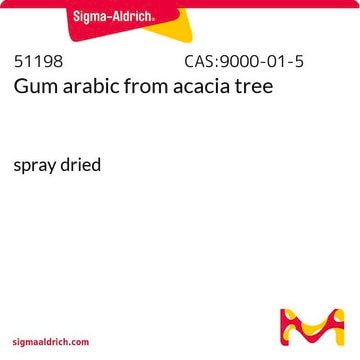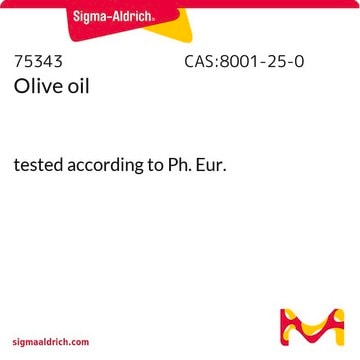If this product has an expiration or retest date, it will be shown on the Certificate of Analysis (COA, CofA). If there is no retest or expiration date listed on the product's COA, we do not have suitable stability data to determine a shelf life. For these products, the only date on the COA will be the release date; a retest, expiration, or use-by-date will not be displayed.
For all products, we recommend handling per defined conditions as printed in our product literature and website product descriptions. We recommend that products should be routinely inspected by customers to ensure they perform as expected.
For products without retest or expiration dates, our standard warranty of 1 year from the date of shipment is applicable.
For more information, please refer to the Product Dating Information document: https://www.sigmaaldrich.com/deepweb/assets/sigmaaldrich/marketing/global/documents/449/386/product-dating-information-mk.pdf
G9752
Gum arabic from acacia tree
branched polysaccharide
Sinónimos:
Acacia gum
About This Item
Productos recomendados
origen biológico
plant (Acacia)
Nivel de calidad
Formulario
powder
color
white to faint beige
temp. de almacenamiento
room temp
¿Está buscando productos similares? Visita Guía de comparación de productos
Descripción general
Aplicación
- as an emulsifying agent to determine lipase activity in shrimps[2]
- for the visualization of mossy fiber sprouting[3]
- as an immunogen and for coating microtitre wells in plate-trapped antigen ELISAs (PTA-ELISAs)[4]
- for silver enhancement for immunohistochemistry[5]
- as a component for Timm′s staining solution[6]
- in nitrocellulose-based soil adhesion assay[7]
- to separate few-layer graphene (FLG) from bulk graphite layers[8]
Otras notas
Código de clase de almacenamiento
11 - Combustible Solids
Clase de riesgo para el agua (WGK)
WGK 3
Punto de inflamabilidad (°F)
Not applicable
Punto de inflamabilidad (°C)
Not applicable
Equipo de protección personal
dust mask type N95 (US), Eyeshields, Gloves
Elija entre una de las versiones más recientes:
¿Ya tiene este producto?
Encuentre la documentación para los productos que ha comprado recientemente en la Biblioteca de documentos.
Los clientes también vieron
-
How can I determine the shelf life / expiration / retest date of this product?
1 answer-
Helpful?
-
-
How is shipping temperature determined? And how is it related to the product storage temperature?
1 answer-
Products may be shipped at a different temperature than the recommended long-term storage temperature. If the product quality is sensitive to short-term exposure to conditions other than the recommended long-term storage, it will be shipped on wet or dry-ice. If the product quality is NOT affected by short-term exposure to conditions other than the recommended long-term storage, it will be shipped at ambient temperature. As shipping routes are configured for minimum transit times, shipping at ambient temperature helps control shipping costs for our customers. For more information, please refer to the Storage and Transport Conditions document: https://www.sigmaaldrich.com/deepweb/assets/sigmaaldrich/marketing/global/documents/316/622/storage-transport-conditions-mk.pdf
Helpful?
-
-
Can you provide a description of the polysaccharide in Gum arabic from acacia tree, Product G9752?
1 answer-
The polysaccharide in gum arabic is branched with a main chain of (1->3) linked β-D-galactopyranosyl units, with side chains of (1->3) β-D-galactopyranosyl units joined to it by (1->6) links. The side chains are two to five units in length. Both main chains and side chains have attached units of α-L-arabinofuranosyl, α-L-rhamnopyranosyl, β-D-glucuronopyranosyl and 4-O-methyl-β-D-glucuronopyranosyl units.
Helpful?
-
-
What is the solubility of Product G9752, Gum arabic from acacia tree?
1 answer-
According to the chemicals encyclopedia published by the Royal Society of Chemistry, 12th ed., Entry# 11, gum arabic is insoluble in alcohols. It is almost completely soluble in twice its weight of water. It is soluble in glycerol and in propylene glycol, but prolonged heating may be necessary for complete solution.
Helpful?
-
-
What is the Department of Transportation shipping information for this product?
1 answer-
Transportation information can be found in Section 14 of the product's (M)SDS.To access the shipping information for this material, use the link on the product detail page for the product.
Helpful?
-
-
Can Product G9752, Gum arabic from acacia tree, be used to extract nuclei from ciliate cells?
1 answer-
This product has been cited for use in a lysis buffer to extract nuclei from ciliate cells. The reference is J. Eukaryotic Microbiology, 43(3), 198-202 (1996).
Helpful?
-
Active Filters
Nuestro equipo de científicos tiene experiencia en todas las áreas de investigación: Ciencias de la vida, Ciencia de los materiales, Síntesis química, Cromatografía, Analítica y muchas otras.
Póngase en contacto con el Servicio técnico









